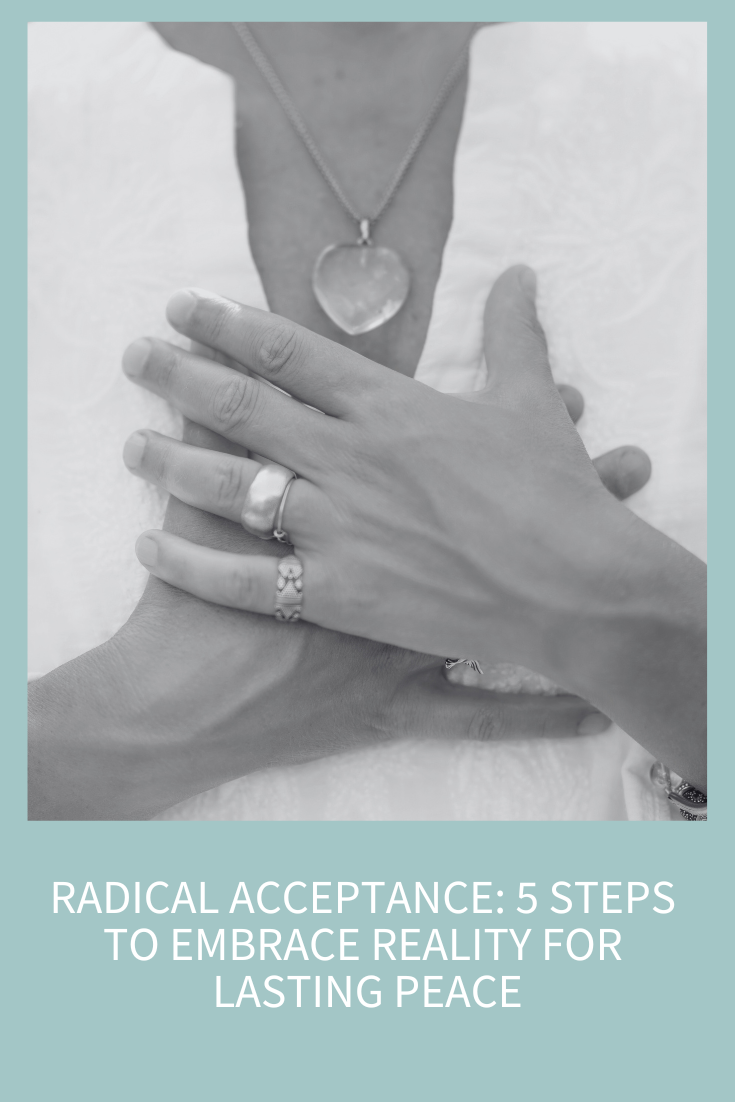
Radical acceptance is about fully acknowledging and accepting reality as it is, especially when it’s something we don’t like or want to change. This approach, popularized by Dr. Marsha Linehan as part of Dialectical Behavior Therapy (DBT), encourages us to embrace what we can’t control instead of resisting it. But radical acceptance isn’t easy. The idea challenges our instincts, often triggering discomfort and frustration, especially if we’re used to holding tightly to that illusion of being in control. Or, if you can’t get past that something isn’t right or fair. Today, we’ll explore the origins of radical acceptance, why it’s so challenging, how you can incorporate this life-changing approach and, of course, my top tips for creating a life of resilience, peace, and healthier relationships.
7-minute read
What is Radical Acceptance?
At its core, radical acceptance is the act of fully accepting your present circumstances, thoughts, and emotions without judgment. This acceptance doesn’t mean approval, resignation, or condoning harmful behavior. Instead, it’s a deliberate choice to acknowledge reality as it is, which frees up emotional and mental energy that otherwise goes to resisting what’s out of your control. Studies show that acceptance practices can improve mental health, lower stress, and build resilience in dealing with life’s challenges.
Why Radical Acceptance is So Hard
Our brains are wired for survival, which means they naturally resist threats or uncomfortable truths. Radical acceptance often requires us to release our instinctive need for control, and research shows that when people struggle with control, they’re more prone to anxiety and stress.
Many of us hold an internal narrative that resisting a situation somehow keeps us safe. But the more we resist, the more we remain trapped in our suffering, and radical acceptance becomes the bridge to breaking this pattern.
I find that the clients who struggle the most with radical acceptance are people who:
- Are control enthusiasts
- Have a strong sense of right and wrong or fairness, so have difficulty pulling back
- Have black-and-white thinking
- Have a history of trauma
- Are prone to rumination
I want to remind you that radical acceptance isn’t for everyone all the time. Instead, it’s about finding where it works for you and taking small steps forward.
Quick Word About ACT
I want to take a moment and talk about acceptance and commitment therapy (ACT), which might be an approach that could work for you although it’s slightly different than radial acceptance, which is within the DBT model of therapy.
ACT is an action-oriented approach therapy, developed by psychologist Steven Hayes of the University of Nevada in the 1980s. With ACT, you learn to stop avoiding or struggling with your emotions and, instead, accept that deeper feelings are normal or appropriate responses to certain situations. The key is that these feelings shouldn’t stop you from moving forward in your life. Instead, you accept that bad stuff happens and commit to changing your behavior, regardless of what’s happening (or happened) and your feelings about it.
It’s all about accepting yourself and your experiences. Hayes felt that we live in a culture that looks to fix any emotion that’s deemed negative instead of seeing these feelings as a natural part of a lived life. While there’s no specific certification in ACT, you can do an online search looking for someone who has experience with this type of therapy, if it interests you. But let’s get back to ways you can incorporate radical acceptance into your life.
Five Ways to Incorporate Radical Acceptance into Your Life
Before I jump into the five concrete ways you can begin integrating radical acceptance into your life, I want to mention that I have a download with ten journaling prompts to help you with your radical acceptance.
In January of 2025, I’ll be starting my Patreon which will be a paid (starting at $5 per month) community where you’ll be getting access to me, more homework, and tips to help you integrate your learning, a community of like-minded people where you all (even without me) can get to know one another and share what’s working and so much more! There will be discounts offered on my programs and merch, no ads to listen to and time with direct Q&A with me.
I want to be clear, though, that I know some of you can’t afford $5 or more per month, and that’s OK. I’ve made a commitment to you that I will be there, and this podcast and all the value you’ve been getting will not change or falter. So, even after January, you’ll be able to count on me to continue to deliver research-based information and tips.
1. Start Small
Begin with minor frustrations. Accept that traffic is slow or that someone’s running late. Practice taking a deep breath and choosing not to ruminate. Consciously choose not to dwell on this situation or person. Imagine yourself putting the situation or feelings of frustration or resentment into a box, instead of holding onto them. You’re gaining a sense of control over your response, even when the situation/person is out of your control.
2. Acknowledge What’s Out of Your Control
Any time you feel frustrated, stop and ask yourself, “Is this within my control?” or “Is this something I can change?” The goal is to observe and not react. These questions serve as grounding moments to help you step back and observe without immediate reaction. For instance, if someone doesn’t respond to a text as quickly as you’d like, remind yourself that their actions are beyond your control. Use this opportunity to explore cognitive reframing. For example, instead of assuming they’re ignoring you, consider that they might be busy or simply forgot.
3. Feel Your Feelings Fully
Radical acceptance isn’t about pushing feelings aside. Instead, it’s about feeling them fully. You’re not ignoring or suppressing difficult emotions. Instead, take time to fully experience your emotions as they arise. Try setting a timer for five minutes and allowing yourself to feel your frustration, sadness, or anger without judgment. Sink into what lies beneath these initial reactions. Often, feelings like sadness, abandonment, or rejection underlie your surface frustrations.
For example, if you feel angry with your partner, ask yourself what’s beneath that anger. Are you hurt, or do you feel unseen? Feeling these deeper emotions without judgment can help you process them, bringing you closer to acceptance.
4. Challenge the “Shoulds” and “What-Ifs”
These words are often clues you’re struggling with acceptance, that you’re clinging to how you wish things were rather than accepting reality. Replace “should” with “it is” or “what if” with “what is.” This shift helps anchor you to reality.
For example, instead of saying, “They should understand my needs,” try reframing it as “They are doing what they can with their own understanding.” Each time you catch a “should” or “what if” in your thoughts, rephrase it aloud if possible. Hearing the revised sentence can help reinforce the mental shift toward acceptance and remind you that life doesn’t have to match your expectations to still hold value.
5. Commit to Accept, Not Approve
Acceptance doesn’t mean you agree with everything or approve of situations that don’t align with your values. You can accept someone’s behavior without endorsing it, and this freedom from emotional resistance can be incredibly empowering. Remind yourself: “I accept this as part of my current reality, but I don’t have to like it.”
For example, if a colleague’s work style conflicts with yours, you can accept that they approach tasks differently without having to feel irritated every time they do something “their way.” This acceptance enables you to focus on what’s in your control (your own tasks and responses) without getting sidetracked by their choices.
Again, remind yourself that acceptance isn’t approval. You can accept a person or situation without agreeing with it. This mindset frees you from emotional resistance.
Wrap Up
Radical acceptance isn’t about giving up; it’s about freeing up your mental and emotional resources for what truly matters. As you begin to incorporate radical acceptance into your life, you’ll find that situations that used to upset you lose their power, and you feel a greater sense of peace. Remember, this is a process—one small step at a time. Give these tips a try and let me know how it goes. Radical acceptance is transformative, and by committing to it, you’re investing in your own peace and happiness.
Resources and Research for Radical Acceptance: 5 Steps to Embrace Reality for Lasting Peace
The Four Ways to Solve Any Problem
How to Stop Overthinking and Let Things Go That Bother You
Radical Acceptance: Embracing Your Life With the Heart of a Buddha by Tara Brach







